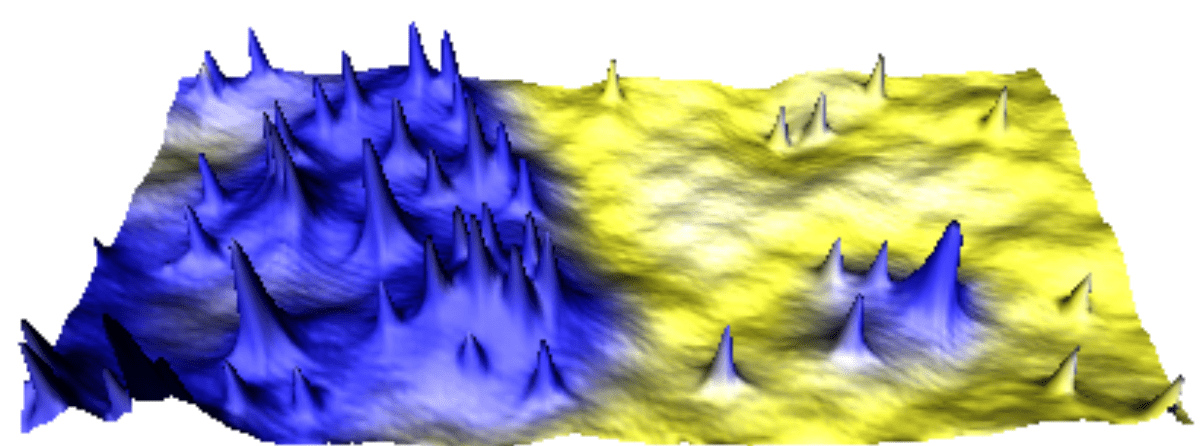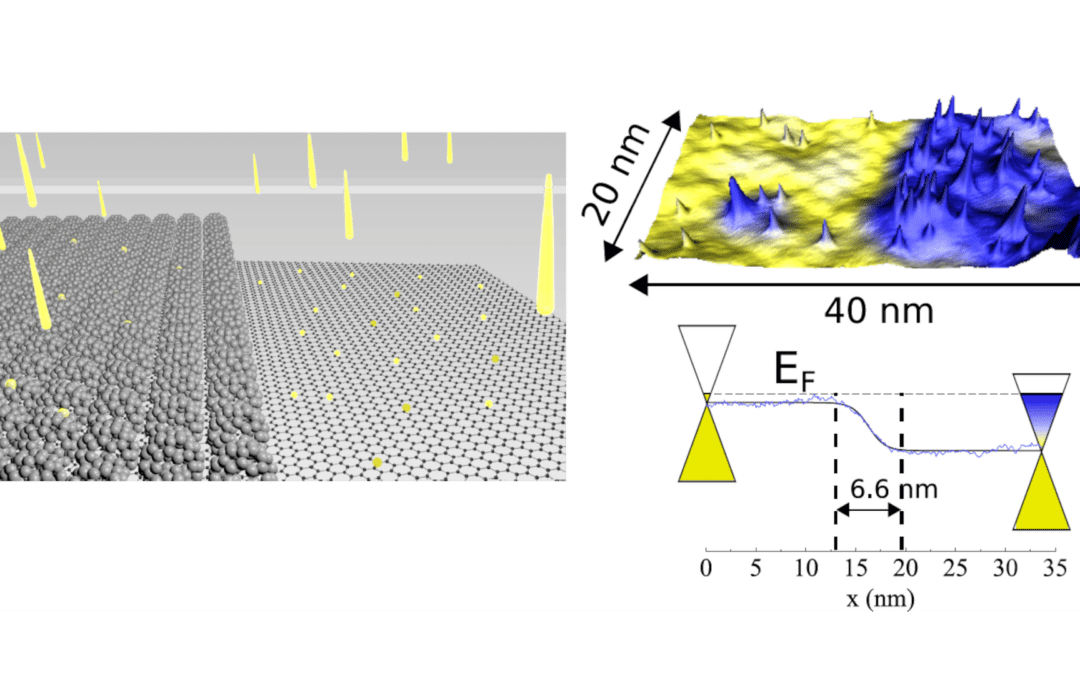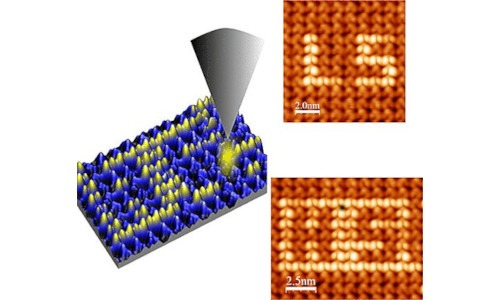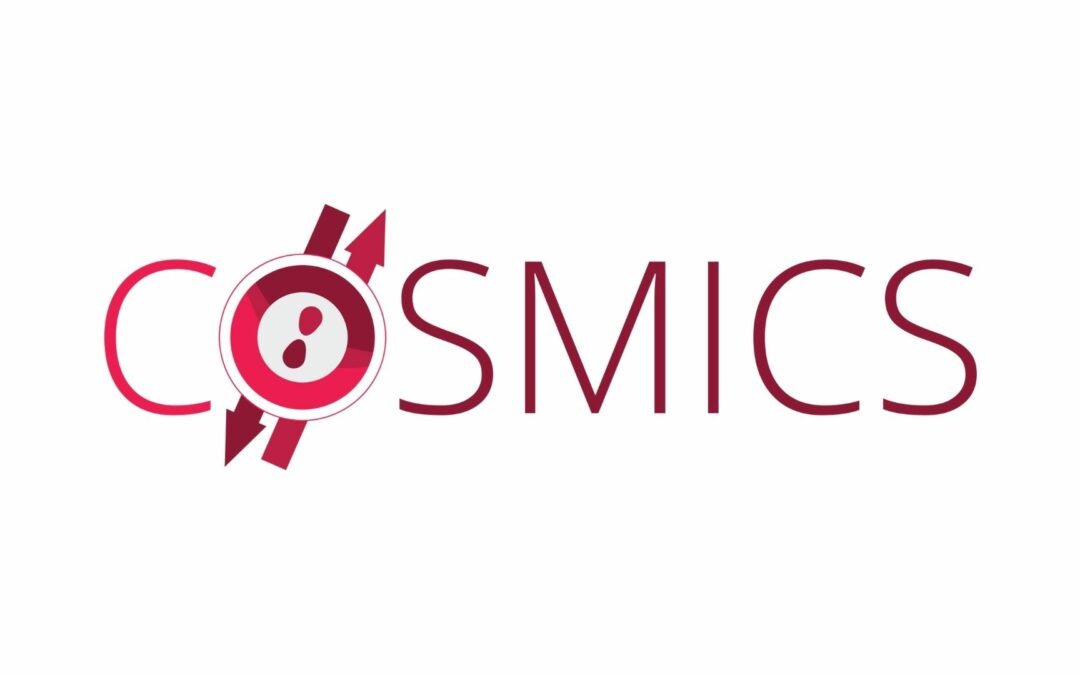Laboratoire: MPQ (Matériaux et Phénomènes Quantiques), Université Paris Cité / CNRS
Adress: Bâtiment Condorcet – 10 Rue A. Domon et L. Duquet – 75013 Paris
Internship/PhD supervisor: Jérôme Lagoute
Tel: 0157276299
e-mail: jerome.lagoute@u-paris.fr

STM image (20 nm x 40 nm) of a nitrogen doped graphene sample color coded with the differential conductance showing a junction between low doped region (yellow) and a high doped region (blue).
The isolation of graphene in 2004 led to the rise of the field of layered two-dimensional (2D) materials that continues to foster tremendous worldwide research activities. In all 2D materials, imperfections are unavoidable. Such imperfections, e.g., vacancies or substitutional/intercalated atoms etc., when combined with the low-dimensionality and enhanced surface/volume ratio, can be engineered to give desirable properties such as reactive catalytic sites, magnetism, or quantum light emission. In this context, defect engineering has recently emerged as a promising strategy to tune the properties of 2D materials including graphene and transition metal dichalcogenides (TMDs) [1].
In this internship, we will use scanning tunneling microscopy (STM) and spectroscopy (STS) operating under ultra-high vacuum and at low temperature (4K) to study the structure and electronic properties of generated defects in graphene at the atomic scale. Our team has recently shown that nitrogen doping in graphene can be controlled at the nanometer scale to realize in-plane pn junctions. STM that can address these junctions at the atomic scale to visualize the potential profile (see Figure) [2]. In this internship we will move further toward defect engineering and combine nitrogen dopants with vacancies. The goal is to reach new functionalities and tune the activity of defects sites from e. g. electro-donor to electro-acceptor. The interaction of the defect sites with molecules will be possibly probed by deposition of organic molecules on top of the functionalized graphene. This work will allow to reach a high degree of control of the chemical activity of graphene that can be useful for diverse applications including catalysis, energy harvesting, sensing. This work can also be extended to other materials such as TMDs. This work may take advantage of several long term collaborations with international partners in Belgium and Taïwan for material synthesis.
[1] F. Joucken, L. Henrard & J. Lagoute. Physical Review Materials 3, 110301 (2019)
[2] M. Bouatou et al., Advanced Functional Materials 32, 2208048 (2022)
À lire aussi

Pint of Science
Plusieurs de nos chercheuses et chercheurs participent au festival Pint of Science, qui fête ses 10 ans cette année. C’est l’un des plus grands festivals de sciences au monde. Jusqu’au 24 mai, les chercheurs et le grand public se rencontrent autour d’un verre, dans 26...

Révéler le profil électronique d’une jonction p-n dans le graphène dopé
Le graphène, constitué d’un feuillet d’atomes de carbone, possède des propriétés physiques uniques et prometteuses dans de nombreux domaines et en particulier en électronique. Figure :Schéma (gauche) représentant un ilot de molécules de C60 utilisé comme masque pour...

Adresser une molécule à transition de spin unique dans un réseau 2D
Les molécules à transition de spin présentant une bistabilité sont particulièrement intéressantes pour le développement de dispositifs électroniques et spintroniques innovants, car elles présentent deux états de spin contrôlables par des stimuli externes. Figure :a)...

La spintronique moléculaire en vidéo
Le projet européen FET-OPEN COSMICS, dont le laboratoire MPQ (resp. Amandine Bellec) est l’un des 6 partenaires, a mis au point une vidéo de présentation de la spintronique moléculaire et des enjeux du projet. Le projet repose sur une collaboration entre différents...
